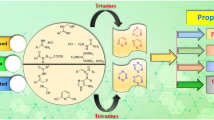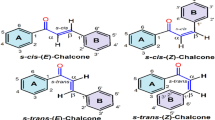Abstract
A series of boron-containing imines derived from isoniazid were prepared and characterized by multi-nuclear NMR and FT-IR spectroscopies as well as elemental analysis. An X-ray diffraction study was performed on the bis-pyridyl derivative, revealing that the imine exists as the E-isomer in the solid state. Potential antibacterial properties were studied against five bacteria strains, including the Gram-negative species Escherichia coli, Klebsiella pneumoniae, Acinetobacter baumannii, Pseudomonas aeruginosa as well as the Gram-positive Methicillin-resistant Staphylococcus aureus (MRSA). Antifungal testing of all compounds was performed on two yeasts, Candida albicans and Cryptococcus neoformans var. grubii. While poor antifungal and antibacterial activities were observed in most cases, appreciable antibacterial activity against MRSA was observed for several compounds while the thiophene-containing derivative displayed significant activity.



Similar content being viewed by others
Data Availability
Available upon request by email from cvogels@mta.ca and is also presented in the online SI section.
References
Řezanka T, Sigler K (2008) Phytochem 69:585–606
Okami Y, Okazaki T, Kitahara T, Umezawa H (1976) J Antibiot 29:1019–1025
Moreira W, Aziz DB, Dick T (2016). Front Microbiol. https://doi.org/10.3389/fmicb.2016.00199
Dembitsky VM, Quntar AAAA, Srebnik M (2011) Chem Rev 111:209–237
Baker SJ, Ding CZ, Akama T, Zhang Y-K, Hernandez V, Xia Y (2009) Future Med Chem 1:1275–1288
Plescia J, Moitessier N (2020) Eur J Med Chem 195:1–20
Farfán-García ED, Castillo-Mendieta NT, Ciprés-Flores FJ, Padilla-Martínez II, Trujillo-Ferrara JG, Soriano-Ursúa MA (2016) Toxicol Lett 258:115–125
Fernandes GFS, Denny WA, Dos Santos JL (2019) Eur J Med Chem 179:791–804
Yang F, Zhu M, Zhang J, Zhou H (2018) Med Chem Commun 9:201–211
Curran MP, McKeage K (2009) Drugs 69:859–888
Shirley M (2016) Drugs 76:405–411
Markham A (2014) Drugs 74:1555–1558
Zane LT, Chanda S, Jarnagin K, Nelson DB, Spelman L, Stein Gold LF (2016) Immunotherapy 8:853–866
dos Santos Fernandes GF, Salgado HRN, dos Santos JL (2017) Crit Rev Anal Chem 47:298–308
Asif M (2012) Int J Pharm Chem 2:110–120
Judge V, Narasimhan B, Ahuja M (2012) Med Chem Res 21:3940–3957
Chohan ZH, Arif M, Shafiq Z, Yaqub M, Supuran CT (2006) J Enzyme Inhib Med Chem 21:95–103
Soni HI, Patel NB (2017) Asian J Pharm Clin Res 10:209–214
Farad H, Jagdale D (2020) World J Pharm Res 9:1581–1588
Blaskovich MA, Zuegg J, Elliott AG, Cooper MA (2015) ACS Infect Dis 1:285–287
Bruker AXS (2016) APEX3, V2016.1-0. Bruker AXS Inc, Madison
Sheldrick GM (2015) Acta Crystallogr A 71:3–8
Sheldrick GM (2015) Acta Crystallogr A 64:112–122
Dolomanov OV, Bourhis LJ, Gildea RJ, Howard JAK, Puschmann H (2009) J Appl Cryst 42:339–341
Farrugia LJ (2012) J Appl Cryst 45:849–854
Iglewicz B, Hoaglin DC (1993) How to detect and handle outliers. ASQC Quality Press, Wisconsin
Nöth H, Wrackmeyer B (1978) Nuclear magnetic resonance spectroscopy of boron compounds. Springer, Berlin
Aakeröy CB, Forbes S, Desper J (2012) CrystEngComm 14:2435–2443
Wang Y-T, Tang G-M, Wan W-Z (2006) Acta Cryst E62:4926–4927
Wardell SMSV, de Souza MVN, Wardell JL, Low JN, Glidewell C (2007) Acta Cryst B63:879–895
Qiu X-Y, Fang X-N, Liu W-S, Zhu H-L (2006) Acta Cryst E62:2685–2686
Guo M-J, Sun J-C, Jing Z-L, Yu M, Chen X (2006) Acta Cryst E62:820–821
Drummond AJ, Waigh RD (2000) Recent Res Dev Phytochem 4:143–152
Sarker SD, Nahar L, Kumarasamy Y (2007) Methods 42:321–324
Nguyen PC, Madani A, Santucci P, Martin BP, Paudel RR, Delattre S, Herrmann J-L, Spilling CD, Kremer L, Canaan S, Cavalier J-F (2018) Int J Antimicrob Agents 51:651–654
Santucci P, Dedaki C, Athanasoulis A, Gallorini L, Munoz A, Canaan S, Cavalier J-F, Magrioti V (2019) ChemMedChem 14:349–358
Nikaido H (1994) J Biol Chem 269:3905–3908
Briers Y, Lavigne R (2015) Future Microbiol 10:377–390
Cama J, Henney AM, Winterhalter M (2019) J Mol Biol 431:3531–3546
Wang J, Sánchez-Roselló M, Aceña JL, del Pozo C, Sorochinsky VAE, Fustero S, Soloshonok VA, Liu H (2014) Chem Rev 114:2432–2506
Zhou Y, Wang J, Gu Z, Wang S, Zhu W, Aceña JL, Soloshonok VA, Izawa K, Liu H (2016) Chem Rev 116:422–518
Purser S, Moore PR, Swallow S, Gouverneur V (2008) Chem Soc Rev 37:320–330
Mishra R, Sachan N, Kumar N, Mishra I, Chand P (2018) J Heterocycl Chem 55:2019–2034
Hamedani NF, Ghazvini M, Sheikholeslami-Farahani F, Bagherian-Jamnani MT (2020) J Heterocycl Chem 57:1588–1598
Puthran D, Poojary B, Nayak SG, Purushotham N, Bhat M, Hedge H (2020) J Chin Chem Soc 67:1278–1288
Acknowledgements
Jason Masuda and Steve Westcott thank the Natural Sciences and Engineering Research Council of Canada, Saint Mary’s University and Mount Allison University for financial support.
Funding
This work was supported by the Natural Sciences and Engineering Research Council of Canada (NSERC) (SAW Grant # RGPIN/04302–2016). The antimicrobial screening performed by The Community for Antimicrobial Drug Discovery (CO-ADD) was funded by the Wellcome Trust (UK) and The University of Queensland (Australia).
Author information
Authors and Affiliations
Contributions
Chris Vogels and Steve Westcott designed the experiments and wrote the manuscript. Thomas Kostelnik and Morgan Morrissey carried out the synthesis and characterization of the compounds. Jason Masuda performed the X-ray crystallography study of 2g.
Corresponding author
Ethics declarations
Conflict of interest
The authors have no competing interests to declare that are relevant to the content of this article.
Additional information
Dedicated to the memory of Dr. Steve Westcott, a great mentor and friend.
Supplementary Information
Below is the link to the electronic supplementary material.
42250_2022_562_MOESM1_ESM.docx
Supplementary file1 Supplementary Information The supplementary crystallographic data for complex 2g (CCDC 2210116) can be obtained free of charge via http://www.ccdc.cam.ac.uk/conts/retrieving.html, or from the Cambridge Crystallographic Data Centre, 12 Union Road, Cambridge CB2 1EZ, UK; fax: (+44) 1223-336-033; or e-mail: deposit@ccdc.cam.ac.uk. Spectroscopic NMR spectra are included in the online supplementary material. (DOCX 2650 KB)
Rights and permissions
Springer Nature or its licensor (e.g. a society or other partner) holds exclusive rights to this article under a publishing agreement with the author(s) or other rightsholder(s); author self-archiving of the accepted manuscript version of this article is solely governed by the terms of such publishing agreement and applicable law.
About this article
Cite this article
Kostelnik, T.I., Morrissey, M.K., Vogels, C.M. et al. Synthesis and Antimicrobial Activities of Boron-Containing Isoniazid Derivatives. Chemistry Africa 6, 1209–1216 (2023). https://doi.org/10.1007/s42250-022-00562-7
Received:
Accepted:
Published:
Issue Date:
DOI: https://doi.org/10.1007/s42250-022-00562-7




